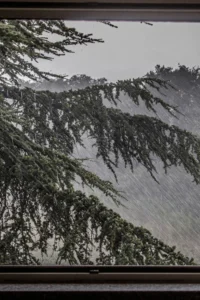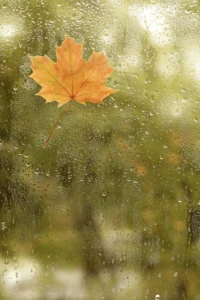Ever stared out your window (or at any glass inside your home) only to be met with unsightly hard water stains on windows? It can be a hassle, but with the right knowledge and tools, you can learn how to get rid of hard water stains on windows.
Let’s dive deep into the causes, prevention methods, and most importantly, effective removal techniques of hard water stains on windows to keep your exterior windows clean.
What Causes Hard Water Stains on Windows?
At its core, hard water is simply water with a high mineral content. These minerals, which cause hard water stains on windows, are primarily calcium and magnesium picked up as water travels through deposits of limestone, chalk, or gypsum.
When this mineral-rich water comes into contact with your windows and evaporates, it leaves behind those telltale cloudy spots and streaks. The culprits behind these stains are often closer to home than you might think. Well water is a common source, but even municipal water supplies can be hard.
Over time, these mineral deposits accumulate, creating stubborn hard water stains on windows that become increasingly difficult to remove. It’s not just an aesthetic issue either – if left untreated, hard water stains can actually etch the glass, causing permanent damage.
Looking for exterior window cleaning to boost the curb appeal of your home? Explore our Houston and Austin window cleaning services to help your home look and feel fresh from the inside out.
Prevention Methods for Hard Water Stains on Windows
An ounce of prevention is worth a pound of cure. Here are some effective prevention methods to keep your windows sparkling clean:
Water Softeners
Water softener devices work by removing the minerals that cause hard water through a process called ion exchange. They use resin beads coated with sodium ions. As hard water passes through, the calcium and magnesium ions are attracted to the resin beads and exchange places with the sodium ions.
Installing a water softener can reduce the mineral content in your water, preventing hard water stains not just on your windows, but throughout your home.
There are several types of water softeners, including salt-based systems, salt-free systems, and dual-tank systems. Factors like your home’s size, water usage, and the hardness of your water when selecting a softener.
Regular Cleaning and Maintenance
In areas with very hard water, you might need to clean weekly, while in other areas, monthly might suffice. After showering or using windows that frequently come into contact with water, a quick wipe with a squeegee can prevent water from sitting and evaporating on the surface.
Microfiber cloths are also excellent for cleaning windows (interior) without leaving streaks. Pair these with a good quality squeegee for best results.
Consider using a spray-on product designed to repel water and prevent mineral buildup. These can be applied after cleaning to provide an extra layer of protection.
Consistency in preventing water spots is key – regular maintenance will save you from dealing with stubborn, built-up stains in the future. But what if you’re already dealing with existing stains?
DIY Removal Techniques
If you’re wondering how to clean hard water stains on windows, there are several window cleaning solutions you can try before calling in the professionals (or to complement your exterior window cleaning services).
Vinegar and Water Solution
Create an effective vinegar and water mixture by combining equal parts of each in a spray bottle. For tougher stains, you can use undiluted vinegar. Spray the solution generously on the affected areas and let it sit for 15 minutes. This gives the vinegar time to break down the mineral deposits.
After letting it sit, wipe the area with a soft cloth or sponge. For stubborn stains, you might need to scrub gently with a non-abrasive pad. Be careful not to use anything too abrasive, as it could scratch the glass.
Rinse the area thoroughly with clean water and dry with a microfiber cloth or squeegee to prevent new water spots from forming. You may need to repeat this process for particularly stubborn stains.
The vinegar method is great because it’s natural, inexpensive, and usually very effective. However, be cautious when using it on tinted or treated windows, as the acidity could potentially damage special coatings.
Lemon Juice Method
If you’re not a fan of the vinegar smell, lemon juice can be a great alternative. It works in much the same way, using citric acid to break down mineral deposits.
To put it to town, squeeze fresh lemon juice into a spray bottle and apply it directly to the stained areas. If you prefer, you can also cut a lemon in half and rub it directly on the glass. The natural acids in the lemon will help dissolve the mineral buildup. Let the lemon juice sit on the stains for about 5 minutes. For tougher stains, you can leave it on for longer, but avoid letting it dry completely as this can leave its own residue.
Wipe the area clean with a damp cloth, then dry thoroughly with a microfiber cloth or squeegee. The fresh scent of lemons is an added bonus to this cleaning method!
Like vinegar, lemon juice is a natural and safe option for most windows. However, it may not be as effective on extremely stubborn stains, and you should still be cautious when using it on specially treated windows.
Baking Soda Paste
For particularly stubborn stains, a baking soda paste can provide the extra oomph you need. The mild abrasiveness of baking soda can help scrub away tough mineral deposits without scratching the glass. Here’s how to use it:
Mix baking soda with a small amount of water to create a paste. The consistency should be similar to toothpaste – thick enough to stick to the window without running off.
Apply the paste to the stained areas using a soft cloth or sponge. Gently rub the paste in circular motions, focusing on the areas with the heaviest buildup. The mild abrasive action of the baking soda will help lift the mineral deposits.
Let the paste sit on the stains for about 15 minutes. This gives it time to work on breaking down the mineral deposits. After waiting, use a damp cloth to wipe away the paste. You may need to rinse the cloth a few times to remove all the residue.
Finish by rinsing the area thoroughly with clean water and employing proper window squeegee techniques for streak-free drying. The baking soda method can be very effective, but it does require a bit more elbow grease than the liquid solutions.
Commercial Products for Hard Water Stain Removal
Sometimes, DIY methods just don’t cut it, especially for long-standing or particularly stubborn hard water stains. These specially formulated cleaners are designed to tackle tough mineral deposits and can be a game-changer when other methods fall short.
CLR Cleaner
For effective limescale removal, CLR (Calcium, Lime, and Rust) is a popular choice for tackling hard water stains. It’s specifically formulated to dissolve these common mineral deposits, making it highly effective on stubborn window stains.
Dilute CLR with equal parts water (unless you’re dealing with extremely tough stains, in which case you can use it at full strength). Apply the solution to the stained areas using a sponge or cloth. Let it sit for about 2-3 minutes, but don’t allow it to dry on the surface.
After letting it work its magic, scrub gently with a non-abrasive sponge or cloth. Rinse thoroughly with clean water and dry the area completely. For safety, always wear gloves and ensure good ventilation when using CLR.
One of the benefits of CLR is its versatility – it can be used on a variety of surfaces beyond just glass. However, it’s a chemical cleaner, so be sure to follow the manufacturer’s instructions carefully and test it on a small, inconspicuous area first.
Bio-Clean Hard Water Stain Remover
For those who prefer a more eco-friendly option, Bio-Clean Hard Water Stain Remover is an excellent choice. This product is non-toxic and biodegradable, making it safer for both you and the environment.
Bio-Clean works through a combination of gentle abrasives and natural enzymes that break down mineral deposits. To use it, simply apply a small amount to a damp cloth or sponge and rub it onto the stained areas in a circular motion.
One of the advantages of Bio-Clean is that it’s safe to use on a wide variety of surfaces, including tinted or treated glass. It’s also less harsh than many chemical cleaners, which means it’s less likely to cause damage if used incorrectly.
While Bio-Clean might require a bit more elbow grease than some chemical alternatives, many users find the trade-off worthwhile for a more environmentally friendly product.
Remember, regardless of which commercial product you choose, always follow the manufacturer’s instructions carefully. These products are powerful and can be harmful if not used correctly.
When to Call the Experts: Geek Window Cleaning
If you’re dealing with extensive exterior window staining, very old and stubborn deposits, glass restoration, or if you’re concerned about potentially damaging your windows, our professional window cleaning services are here to help!
Our professional window cleaning services and ACP Program ensure any exterior hard-water stains are made fresh and clean. Contact us today to make your home as clean as when you moved in!



Recent Comments